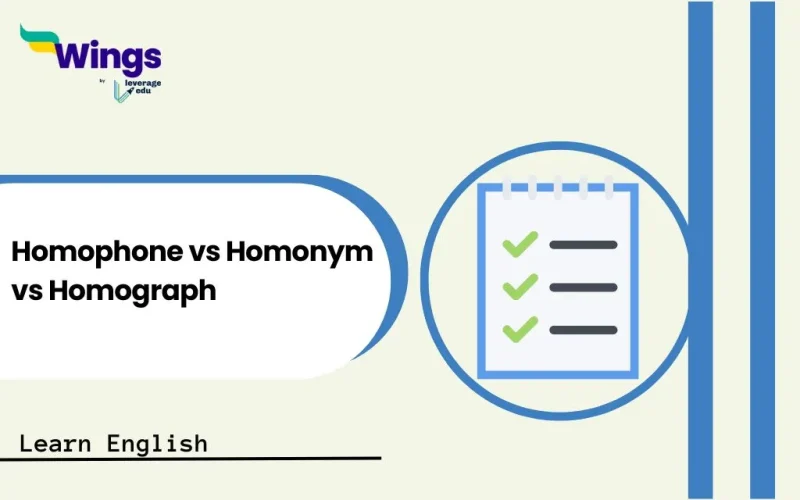We all know that the English language is full of tricky words and can be confusing as they might sound or look alike. If you are also going through the situation then you are not alone! Many people struggle to distinguish between homophones, homonyms, and homographs. Well, to make things easier for you we have compiled this blog post where you will find the difference between Homophone vs Homonym vs Homograph, how they should be used in the formation of sentences, common mistakes which people make and finally some practice exercises to check your knowledge.
This Blog Includes:
Understanding Homophone vs Homonym vs Homograph
Let us now look at the basic difference between homophone vs homonym vs homograph in detail with examples.
What are Homophones?
Homophones also called ‘soundalikes’ are words that sound the same but have different meanings and often different spellings. They can create confusion in both written and spoken language, making it important to understand their distinctions.
For example, “to,” “too,” and “two” are classic examples of homophones, where each word has a distinct meaning despite sounding identical.
Furthermore, homophones can be categorised into two types:
- Heterographs: These are homophones that are spelt differently (e.g., “flour” and “flower”).
- Homographs: These can be spelt the same and pronounced the same but have different meanings (e.g., “lead” as in to guide and “lead” as in a type of metal)
| The term “homophone” derives from the Greek prefix homo- meaning “same” and phone meaning “sound,” which literally translates to “same sound”34. |
Examples of Homophones
After you have understood what are homophones, let us now look at some of these examples for better understanding.
| Homophone 1 | Meaning | Homophone 2 | Meaning |
| To | Preposition/Infinitive | Too | Also/Excessively |
| There | Location/Existence | Their | Belonging to them |
| They’re | They are | Their | Belonging to them |
| Write | Inscribe letter | Right | Correct/Direction |
Also Read: What are Homophones?
What are Homonyms?
Homonyms are words that share the same spelling and pronunciation but have different meanings. Homonyms are characterised by identical spelling and pronunciation. For instance, the word “bat” can refer to a flying mammal or a piece of sports equipment used in baseball.
Despite their identical forms, homonyms have different meanings based on context. For example, “bark” can mean the sound a dog makes or the outer covering of a tree.
| The term comes from the Greek roots “homo,” meaning “same,” and “nym,” meaning “name.” This means that homonyms can sound alike or be spelt the same, yet they convey distinct meanings. |
Examples of Homonyms
Let us look at the examples below for a better understanding.
| Homonym | Meaning 1 | Meaning 2 |
| Bark | The dog’s bark was loud. | The tree’s bark is rough. |
| Match | She lit a match to start a fire. | The soccer match was thrilling |
| Well | The old well provides fresh water. | She felt well after resting. |
| Left | He left the room quietly. | The book is on the left side of the shelf. |
| Ring | She wore a gold ring on her finger. | The phone rang during dinner. |
Read more on Difficult Homonyms with Examples
What is Homograph?
A homograph also known as ‘look-alike’ is a word that is spelt the same as another word but has a different meaning, and it may or may not have a different pronunciation. Homographs share identical spelling, which distinguishes them from other types of words that sound alike but differ in spelling.
Each homograph has a unique and different meaning that is context-dependent. For example, the word “lead” can refer to a type of metal or to guide someone.
However, some homographs are pronounced the same way (e.g., “bat” as in the flying mammal and “bat” as in sports equipment), while others have different pronunciations (e.g., “tear” as in to rip vs. “tear” as in a drop of liquid from the eye).
| The term “homograph” comes from the Greek words homo, meaning “same,” and graph, meaning “writing.” |
Examples of Homograph
Following are some examples of homographs for a better explanation.
| Homographs | Meaning 1 | Meaning 2 |
| Bow | To bend forward (verb) | A weapon for shooting arrow |
| Tire | To exhaust (verb) | A rubber covering for a wheel (noun) |
| Row | A line of thins (noun) | To propel a boat with oars (verb) |
| Lead | To guide (verb). | A type of metal (noun). |
| Wind | Moving air (noun) | To twist or turn something (verb) |
Read More: Homophone vs Homonyms
Key Differences Between Homophone vs Homonym vs Homograph
The table below summarises the key difference between homophone vs homonym vs homograph highlighting their definitions, spelling characteristics, pronunciations and examples.
| Aspect | Homophones | Homographs | Homonyms |
| Definition | Words that sound the same but have different meanings and may have different spellings. | Words that are spelt the same but have different meanings and may have different pronunciations. | Words that share the same spelling and pronunciation but have different meanings. |
| Spelling | Different (e.g., “flour” vs. “flower”) | Same (e.g., “lead” as in to guide vs. “lead” as in the metal) | Same (e.g., “bat” as in the animal vs. “bat” as in sports equipment) |
| Pronunciation | Same (e.g., “to,” “too,” “two”) | Same or different (e.g., “tear” as in to rip vs. “tear” as in a drop of liquid) | Same (e.g., “ring” as in jewellery vs. “ring” as in a sound) |
| Examples | “sea” / “see”- “right” / “write”- “pair” / “pear” | – “wind” (air) / “wind” (to twist)- “tear” (rip) / “tear” (from the eye)- “row” (line) / “row” (to paddle) | – “bark” (dog sound) / “bark” (tree covering)- “bat” (flying mammal) / “bat” (sports equipment)- “lead” (to guide) / “lead” (met |
Also Read: Difficult Words with Meaning in English Vocabulary
Common Mistakes and How to Avoid Them
Common mistakes involving homophone vs homonym vs homograph can lead to confusion in writing and communication. Here are some common errors and tips on how to avoid them:
| Type | Common Mistakes | How to Avoid |
| Homophones | Confusing “to,” “too,” and “two.”Mixing up “there,” “their,” and “they’re.”Using “flour” instead of “flower.” | Remember that “to” is a preposition, “too” means also or excessively, and “two” is a number. Use mnemonic devices to remember the meanings. Contextualise sentences to clarify which word fits. |
| Homographs | Misunderstanding the meaning of “lead” (to guide) vs. “lead” (the metal).Confusing “tear” (to rip) with “tear” (a drop of liquid). | Pay attention to context clues in sentences to determine the correct meaning. Familiarise yourself with common homographs and their meanings. |
| Homonyms | Using “bark” (dog sound) when meaning “bark” (tree covering).Confusing “bat” (animal) with “bat” (sports equipment). | Context is key; ensure the surrounding words clarify the intended meaning. When in doubt, rephrase the sentence for clarity or consult a dictionary. |
Homophone vs Homonym vs Homograph: Practice Exercises
After you have got a basic understanding of homophone vs homonym vs homograph, it is now time to test your understanding with the help of these exercises which we have prepared for you. You will also find answers to these exercises at the end.
Exercise 1: Match the Following
Instructions: Match the term with its correct definition:
| A. Homophone | Words that are spelt the same but have different meanings and may or may not be pronounced the same. |
| B. Homonym | Words that sound the same but have different meanings and spellings. |
| C. Homograph | Words that are spelt and pronounced the same, or spelt the same but pronounced differently, but have different meanings. |
Check Answers:
- 2) Words that sound the same but have different meanings and spellings.
- 3) Words that are spelt and pronounced the same, or spelt the same but pronounced differently, but have different meanings.
- 1) Words that are spelt the same but have different meanings and may or may not be pronounced the same.
Exercise 2: Identifying the Type
Instructions: For each pair of words, identify whether they are homophones, homonyms, or homographs:
- Bat (animal) / Bat (baseball equipment)
- To / Too / Two
- Lead (to guide) / Lead (a metal)
- Flour / Flower
- Address (location) / Address (to speak to)
Answer Key:
- Homonym
- Homophone
- Homograph
- Homophone
- Homograph
Exercise 3: Fill in the Blanks
Instructions: Choose the correct word from the pair in parentheses to complete the sentence:
- I need a (piece/peace) of paper to write on.
- The (bear/bare) was sleeping in the woods.
- She will (write/right) a letter to her friend.
- The (cell/sell) phone rang loudly.
- Please (read/reed) the book.
Answer Key:
- Piece
- Bear
- Write
- Cell
- Read
Explore similar blogs from Learn English!
FAQs
Here is how you can explain homophone vs homonym vs homograph:
Homophones: Sound the same, different spelling, different meaning (e.g., “there,” “their,” “they’re”).
Homonyms: Sound or look the same, different meaning (e.g., “bat” – animal vs. object).
Homographs: Spelled the same, different meaning, sometimes different pronunciation (e.g., “lead” – metal vs. to guide).
“Bat” can refer to either baseball equipment or a winged mammal. Both definitions have the same pronunciation, hence “bat” is both a homograph and a homophone.
Words, like bark, fall into multiple categories—bark on a tree and bark of a dog are both homophones (sounding the same) and homographs (spelt the same).
The word “duck” is classified as a homonym because it has the same spelling and pronunciation but can have different meanings based on context. The two primary meanings of duck are ‘a bird’ and ‘one who lowers their head or body quickly to avoid something.’
The homonym of “maid” is “made.”
Here’s a breakdown:
Maid: A female domestic servant.
Made: The past tense of the verb “make.”
They sound the same but have different spellings and meanings, making them homophones. Because they sound the same they are also homonyms.
We hope this blog on “Homophone vs Homonym vs Homograph” helped you improve your English skills. You can also follow the Learn English page of Leverage Edu for more exciting and informative blogs related to English grammar and the English language
 One app for all your study abroad needs
One app for all your study abroad needs















 60,000+ students trusted us with their dreams. Take the first step today!
60,000+ students trusted us with their dreams. Take the first step today!

